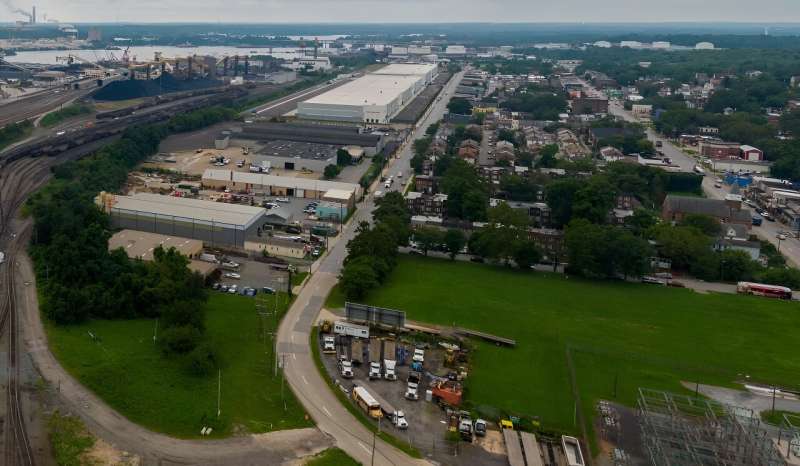This article has been reviewed according to Science X's editorial process and policies. Editors have highlighted the following attributes while ensuring the content's credibility:
fact-checked
trusted source
proofread
Researchers capture unique pollution data following Key Bridge collapse

When the container vessel Dali crashed into the Francis Scott Key Bridge causing it to collapse in Baltimore Harbor on March 26, 2024, deliveries to the busy port via ship were halted, and the number of trains and trucks coming into the city dropped dramatically as well.
NOAA researchers immediately knew that there would be unique data to capture while the port was shuttered. Large trucks, piles of coal, and the machinery used to power cranes and ships all contribute to particulate matter in the air and to pollution. Since early April 2024, a team from the NOAA's Air Resources Lab have been taking air samples in the Curtis Bay neighborhood immediately to the east of the bridge. They hope to provide new insights into the impacts of transportation on air quality for local communities.
Their tool for measurement—a sport utility vehicle or SUV—may seem counterintuitive, since vehicles contribute to overall emissions.
But the fine spatial scale of urban pollutants such as black carbon require a tool that samples at the level where people live and breathe. Some neighborhoods can be much more impacted than others due to topography, roads and the location of various buildings. NOAA's Air Resources Car, NOAA's ARC, was built as a mobile measurement platform inside an SUV. The size of the vehicle's interior allows it to hold different sampling equipment.
Since March 2022, NOAA researchers have been driving NOAA's ARC around several cities to measure sources of greenhouse gases and air pollutants in the Baltimore-Washington region and other parts of the Northeast Corridor. These SUV-gathered measurements are then added to data gathered at several ground stations that operate 24/7 and through all seasons, all types of weather, and throughout changing traffic patterns in the region. (And yes, the measurements do account for the emissions from the vehicle itself.)
Data from NOAA's ARC has been used by the Maryland Department of the Environment, and researchers from ARL have worked with Johns Hopkins University Bloomberg School of Public Health, University of Maryland and the Community of Curtis Bay Association on several studies of area pollution. The team's previous work in the area will soon be compared with the new data to see if any significant changes have occurred in the air quality. Measurements will continue as the port returns to business-as-usual, and the NOAA team anticipates that preliminary results of this specific project will be available in late 2024.
The tragic collapse of the iconic Francis Scott Key bridge that took the lives of six men has also taken a toll on the city and the people who live in Baltimore, leaving many out of work for the indefinite future.
![A playground near the CSX Coal Field in Curtis Bay, Baltimore, Maryland on October 26, 2023. [Panorama drone photograph]. Credit: R. Gattis, Community of Curtis Bay Association Researchers capture unique pollution data following Key Bridge collapse](https://scx1.b-cdn.net/csz/news/800a/2024/researchers-capture-un-1.jpg)
But, says NOAA researcher Xinrong Ren, pollution from heavy industry has also long been an issue of environmental justice in Curtis Bay, a racially diverse neighborhood with a median household income of $38,281—almost half the national level. Unemployment and family poverty are higher here than national averages and higher than the average of Baltimore as a whole.
Robust industry supports economic growth but understanding industry's environmental impacts could be key to reducing pollution when the port is once again bustling and full of ships and the new bridge is full of trucks and cars.
"We know that transportation choices can impact people who live near factories and ports," says Ren. "This huge change in ship traffic can provide a really interesting baseline comparison to times when the port is busy and full of traffic."
Greg Sawtell volunteers for the Community of Curtis Bay Association, and he previously lived there and currently works for the south Baltimore community land trust. He's seen black dust mix with the sweat on children's faces as they play at nearby playgrounds in the summer. He's glad that the community is increasingly becoming a very active part of air pollution research, and that residents here are being asked what needs to be studied but he notes that "what matters is what we do with the information."
Tiffany Thompson, a resident who also used to teach at nearby Curtis Bay Elementary, says that many of her former students suffered from asthma. She is proud of community members from across South Baltimore, including her own daughter, who have come together for the sake of a healthier community and a better way of life. But she wants to see real change happen.
"Decades of intense environmental injustice has already cost South Baltimore the displacement of at least three entire communities," Thompson says. "We need to see all this research turn into concrete action that makes our lives better. It hasn't happened yet and we will keep going until we see it."
Provided by NOAA Headquarters




















